#refugium2024
Explore tagged Tumblr posts
Text
My Refugium creature design contest entry

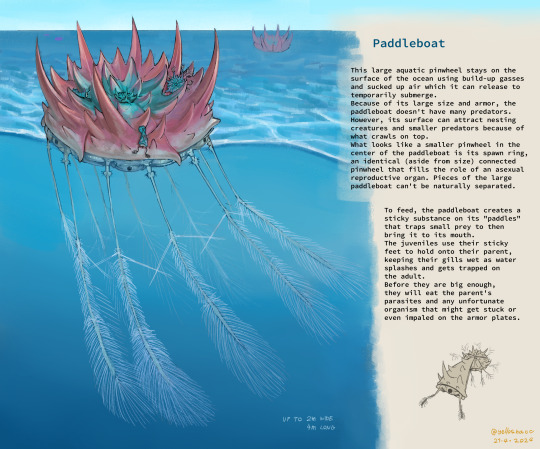
It's one sharp float.
Here's the text closeup tumblr forgot when this got posted.
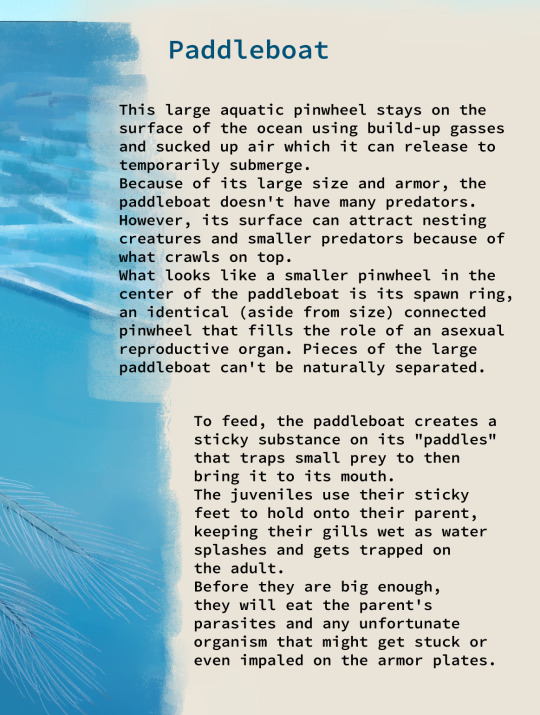
#refugium2024#art#speculative biology#artists on tumblr#digital art#artwork#alien design#spec bio#refugium#pinwheel
874 notes
·
View notes
Text
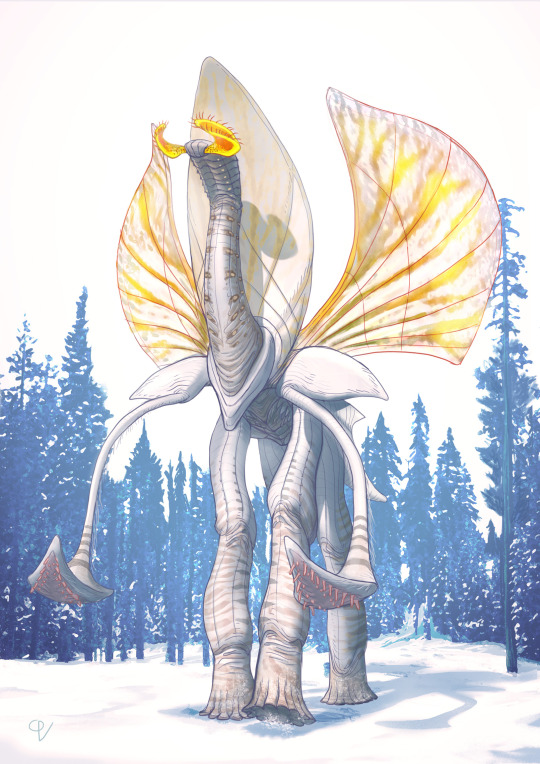
Here's my entry for the spectacular #Refugium2024 contest, arranged by @simon-roy on the occasion of his comic Kickstarter!
Because there were five different clades to choose from, I ultimately picked the photosynthetic "pentaped". It wasn't my first choice, though, as I love the idea of the crustacean-like "skilloids", but the five-legged plant animals seemed like they could be a hell of a challenge. So here is the Helioceros (aka Cherubic Pentaped), an alpine species that stores and uses sunlight as an energy source and for displaying behavior.
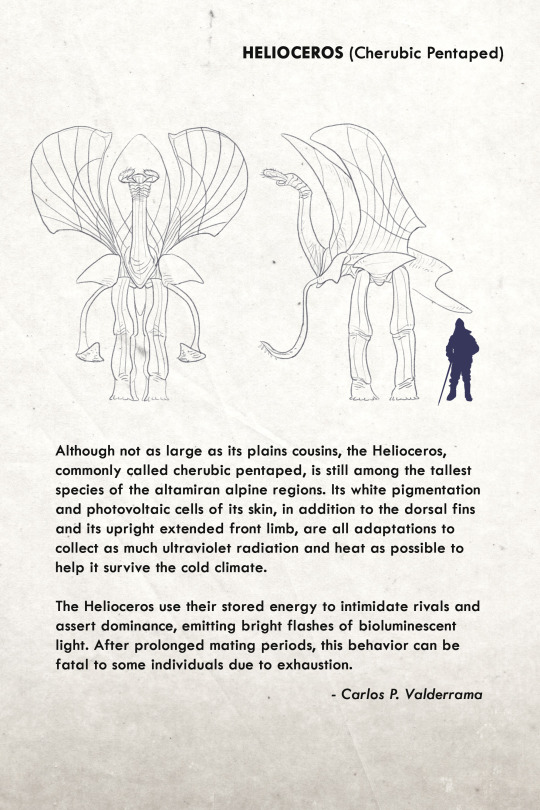
Hope you like it! And hey, do not forget to support the Refugium comic! Not every day do we come across projects as cool as this!
874 notes
·
View notes
Text




One of my favorite, and most frivolous items, for the kickstarter - a booklet of paper dolls! Featuring characters from throughout the new book and previous books (Betty being the star of "REFUGIUM", at least in the eyes of fans)
The campaign is down to the last three days, so go take a look!
https://www.kickstarter.com/projects/grizgrobus/a-star-called-the-sun?ref=2j478m
#refugium2024#griz grobus#simon roy#comics#scifi#sciencefiction#kickstarter#speculative biology#image comics#speculative zoology#super goat#paper dolls
110 notes
·
View notes
Text

Didn't think I'd have the time but got my entry for the refugium creature contest done! Down to the wire as usual. More info on the life cycle found below!
I wanted to do a fun Squilloid line, but as fun belly worms! The life cycle is the host eats the eggs which hatch inside the digestive tract, once there the young attack each other and any other parasites they find. They 'eat' through absorption through their tails so their mouth parts are only for clearing out their living space, as a result most hosts generally feel a lot better once they are infected. The fools!
Once the role of top worm has been decided, the individuals morphs into the feeding stage of their lifecycle. Their tail sprouts a multitude of fringes to aid in absorbing food and gas exchange, while the mouth parts remain for dealing with any would be room mates! This stage of their life is by far the longest, lasting decades.
The burrowing phase is where the fun begins, this sub adult form can be brought about by age, stress, or most commonly lack of space within the host. In this phase they begin swelling grotesquely and once they reach maximum size, turn their mouth upon their host. They chew their way out to the surface, sometimes resulting in death, sometimes not! But they only stop once they are able to smell open air and then settle in to begin their final metamorphosis.
The dispersal phase adults only live for a few days, climbing out of the wound created in their host to fly off and find suitable places to lay their eggs. If their host died during the last phase they will generally lay their eggs onto the body, but some are always out looking to lay a trap for the next poor unsuspecting creature.
Hope you enjoy! There are so many fun entries, def go check them out!
#theyre like if a tapeworm was also a fig wasp#refugium2024#art#speculative biology#spec bio#Squilloid#you KNOW i had to make on that was disgusting
803 notes
·
View notes
Text

A quick fan Grappler of @simonroyart 's Refugium comic: The Ciggy Badger "With refuse often mistaken for signs of humanity, Ciggy Badgers roll leaves together and light them with a sparking "tooth" to smoke out parasites and ward predators. This skill is seemingly instinctual rather than intellectual."
513 notes
·
View notes
Text
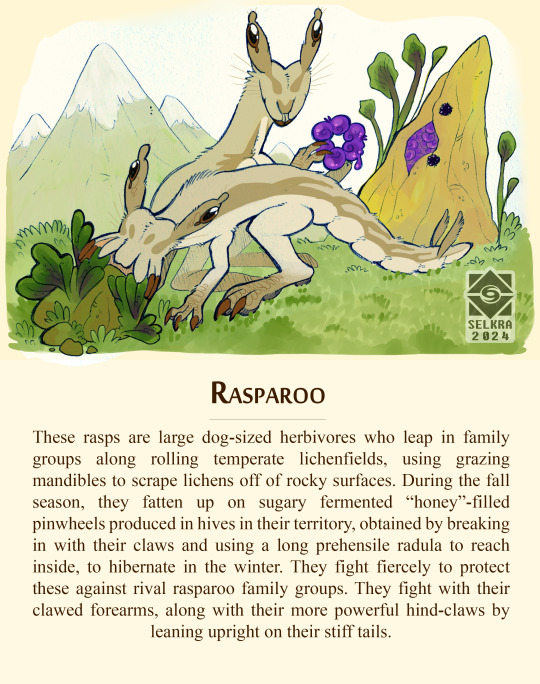

Cutting it close, but here's my entries for the Refugium Creature Design Contest! @simon-roy
The rasparoos are large dog-sized herbivores who leap in family groups along rolling temperate lichenfields, using grazing mandibles to scrape lichens off of rocky surfaces. During the fall season, they fatten up on sugary fermented “honey”-filled pinwheels produced in hives in their territory, obtained by breaking in with their claws and using a long prehensile radula to reach inside, to hibernate in the winter. They fight fiercely to protect these against rival rasparoo family groups. They fight with their clawed forearms, along with their more powerful hind-claws by leaning upright on their stiff tails.
Honey rings are social pinewheels that live in nests as colonies in temperate lichenfields. Their caste system includes workers, the smaller motile form who go out of the colony to collect vegetable matter during warmer seasons to ferment in their stomach acids and store as “honey” in the hive for the snowy seasons. The other caste are the reservoirs, who are blind, sessile and much larger than workers, with characteristic spiral body cavities to store a maximum amount of “honey”. Some of it seeps out of their bodies to stick with one another securely in the hive, aided by their gripping legs clinging to the walls of the hive.
I had a lot of fun with these guys! You can see concept sketches here because I think they're fun.
#refugium2024#selkra scribbles#my art#speculative biology#spec bio#speculative zoology#astrobiology#xenobiology#alien design#alien#artists on tumblr
500 notes
·
View notes
Text
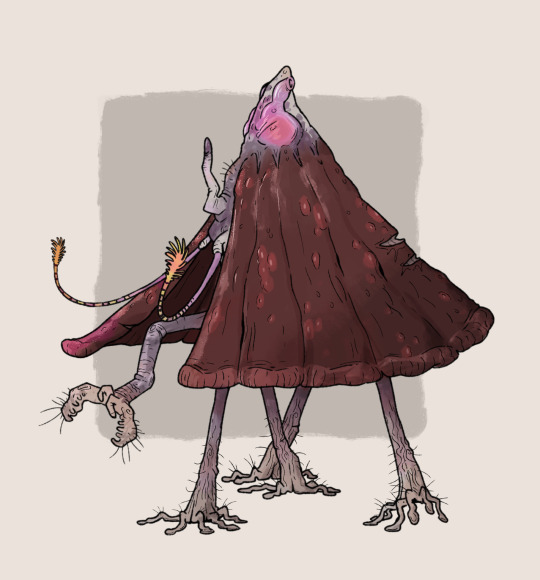
The Crone's Mantle
Traipsing through the marshy lowlands of Western Altamira's south, one may come across an unusual member of the pentapoda, colloquially known as the Crone's Mantle.
This shallow-water specialist, standing 7 feet tall at the peak, spends the warm months similarly to most large pentapods, feeding on water plants and drawing much of its energy from the sun. Come the shorter days of the cold season, however, the Mantle seeks a different source of energy.
Conserving what limited energy it can draw from sunlight during the short days, the Mantle roots itself in place along shallow stretches of rivers and streams. Its unusual downturned sails create shade that attract small squilloids, which, upon sensing the movement with its bristly legs, are snatched out of the water with its anterior appendage and flung into the Mantle's ventral mouth.
The Mantle shares its home with a variety of semiaquatic rasps, wading terrestrial squilloids and - most notably - predatory grapplers. The slow-moving Mantle defends itself with loud trumpeting from two respiratory organs atop its conical back, and if that's not enough, its ventral sails secrete a foul-tasting oil that deters most predators.
Hopefully not too late @simon-roy
318 notes
·
View notes
Text
#refugium2024
I ONLY JUST FOUND OUT ABOUT #refugium2024 TODAY SO I SPEEDRAN THIS ENTRY ASIJDFUDSHDISKASDN


This is a Willoh (short for "will-o'-the-wisp"), these pelagic squilloids live in the deep sea in large schools but at night travel up in the watern column following the movement of smaller animals and Altamiran zooplankton which they feed on.
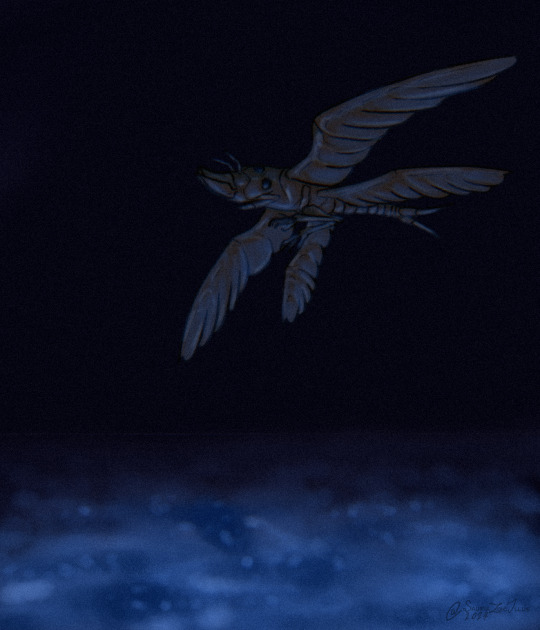
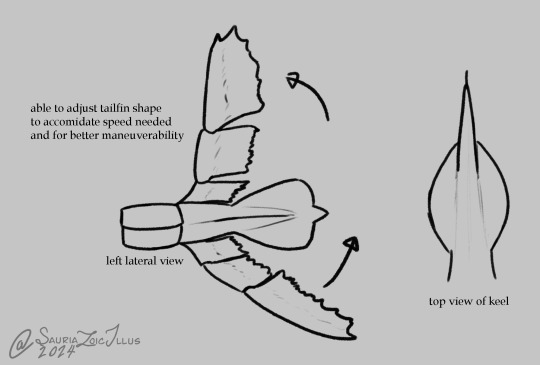
their bioluminescence not only confuses predators as they swim in large schools in the dark, but also as social signalling to let other Willoh know where they are, their schools can be millions strong and comprise a significant part of Altamira's marine biomass.
#digital art#artists on tumblr#digital artwork#digital illustration#id in alt text#specevo#speculative evolution#speculative biology#xenobiology#spec evo#spec bio#speculative zoology#refugium2024
100 notes
·
View notes
Text
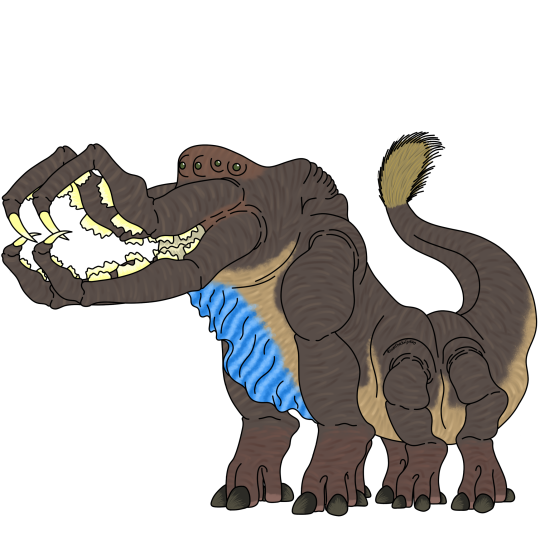
A bit of a last minute entry for @simon-roy’s refugium contest. I was pretty on the fence on if I should join but I decided why not! And it was a good excuse to try some new brush techniques.
————-
An excerpt from the Altamira Book of Wildlife
An illustration of a male Towering Snappler, so named for the snapping sounds accompanying their feeding. Snapplers are aberrant grapplers that have taken up high browsing niches. The same raptorial appendages of the family are also useful for grabbing and manipulating the branches of foliage, and so they fill a similar niche to many earthen high browsers such as elephants, chalicotheres, therizinosaurs, and sauropods. Towering Snapplers themselves average around 35-40 tons, which is a similar size range to some iconic Jurassic sauropods such as Brontosaurus and Apatosaurus. Snapplers sometimes come into conflict with some Pentapods over resources as they too can sometimes fill similar niches, but these rarely become full confrontations as the photosynthesis and bio-voltaics of Pentapods allows them to go longer between meals.
The raptorial arms manipulate and crush foliage and bark using their claws and grinding teeth that are similar to elephant teeth. Food is then shoved down their powerful beaks to be further processed in a large crop before fermenting in their gut.
Towering Snapplers typically live in herds mostly composed of females and young with a few males, and they communicate using signaling via their tail brush. Males have bright blue dewlaps, and since blue is a very expensive color in nature, brighter blues are a good sign of fitness. During breeding season only one dominant male may get breeding rights, and so males compete with each other. They flash their dewlaps at each other and raise their tail brushes high, and if that doesn’t decide a victor then they may engage in a “parallel march” like deer to gauge the size of their opponent. If either party still doesn’t back down then the last step is physically fighting with their raptorial appendages. This last step rarely happens, but it can escalate to the point of being fatal. Old experienced males are adorned with scars from previous battles. The male illustrated here has only just reached sexual maturity and lacks any scars.
#refugium2024#speculative ecology#speculative zoology#speculative evolution#xenobiology#refugium#simon-roy
81 notes
·
View notes
Text
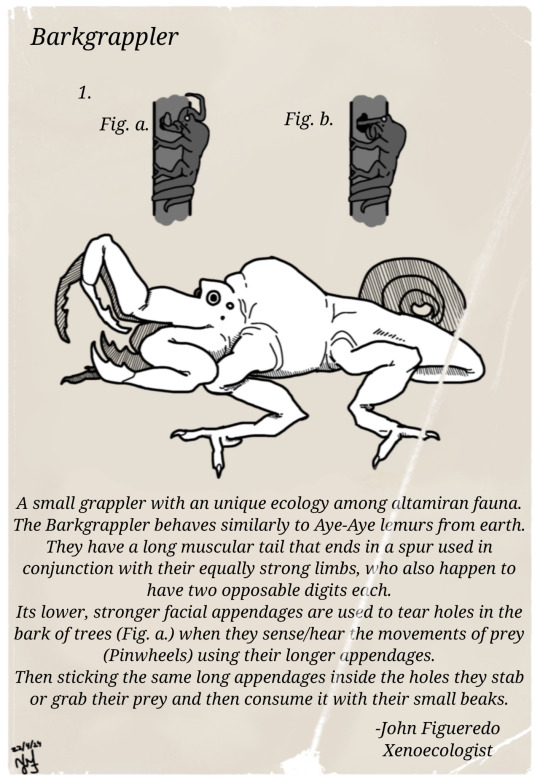
My contribution to @simon-roy 's Refugium Bestiary contest
#refugium2024#refugium#worldbuilding#my art#art#illustration#speculative biology#spec bio#spec evo#speculative zoology#speculative evolution
119 notes
·
View notes
Text

The ruidísimo is found in only a handful of forests around Altamira, but it isn’t hard to find them in what few areas they live thanks to the unmistakable woodpecker-on-steroids-esque noise that they produce while hunting. These creatures, unlike the closely-ish-related elefantito, use rapid thrusts of their hydraulic thorn-tongues to drill through wood, where they hope to find small creatures to prey on. This drilling can be fairly taxing, physically and energetically, though the impact is dampened a little by their thick, sturdy neck muscles.
As of now, ruidísimos do not live anywhere near human settlements, which is good news for anyone who likes sleeping. If this were to change, however, the people of Altamira would quickly be plagued by structural damage as the encroaching ruidísimo population drills holes into any and every wooden structure they can find. That, and the noise. Dear god, the noise…
#refugium2024#can you tell this is my first time using procreate#art#spec bio#speculative biology#tw trypophobia#my art
59 notes
·
View notes
Text

Here is my entry for @simon-roy 's #refugium2024 contest, I had a lot of fun with this one. I think it's closest to squilloid clade. 🤔
Maybe designing a terrestrial, spicy shrimp is what I needed to get back in the groove.🦐🔥
I was listening to Barbie soundtrack when drawing, so this oversized shrimp is now named Ken.
#speculative biology#speculative evolution#digital art#concept art#creature design#alien design#worldbuilding#scifi#refugium2024#xenobiology#spec evo#spec bio
30 notes
·
View notes
Text

the pinwheel pentaped a divergent pentaped species who uses it's limbs as a method to generate energy. Really cool but because they necessitate so much metal in their biology they are incredibly rare even on the island they evolved on.
13 notes
·
View notes
Text



Hey if you're on goodreads, and you've read and enjoyed any of our last three books books - head on over and give us some love!
#simon roy#comics#griz grobus#habitat#sciencefiction#kickstarter#image comics#refugium2024#speculative biology#speculative zoology#miramar#waterworld
71 notes
·
View notes
Text
Beware, for this strange monstrosity stalks the woods of Altamira, seeking out the most worthy prey not to fill its stomach, but to fulfill the gnawing void of boredom!
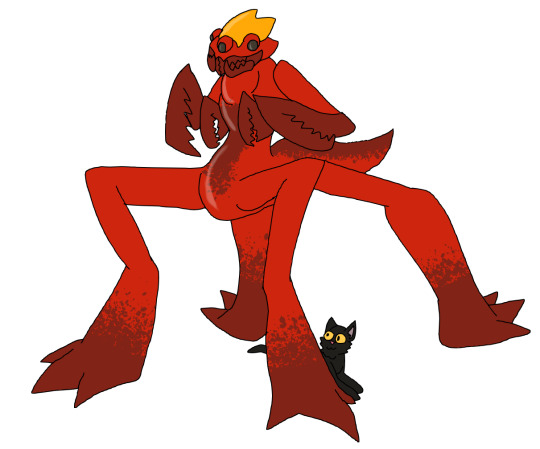
Oh, and for some reason it's been sticking around this forest strider who's taken a bit of a liking to it.
17 notes
·
View notes
Text
Thought I’d post some art I did for the #refugium2024 of one of my grappler variations. I don’t know much of the world so I went with what felt right.

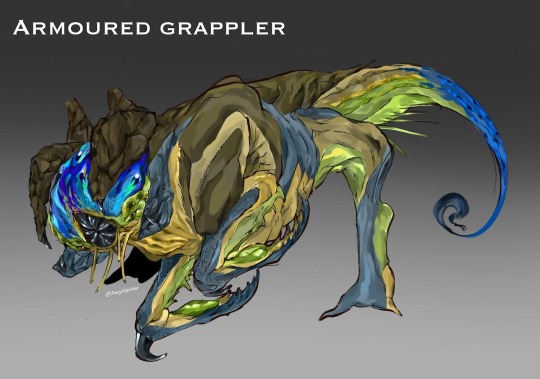
#spec bio#speculative biology#speculative evolution#spec evo#speculative fiction#xenobiology#alien species#artists on tumblr#speculative ecology#speculative worldbuilding
76 notes
·
View notes